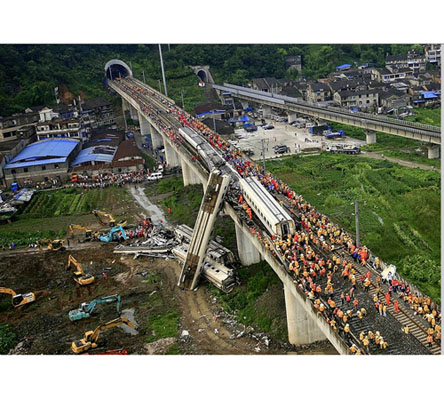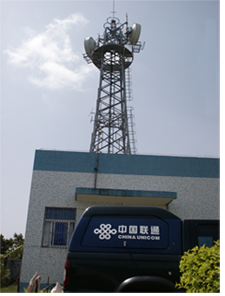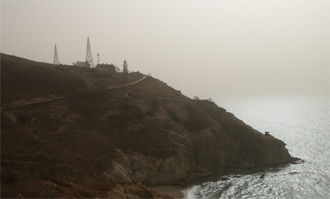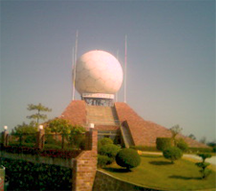TEN350 The waveform that hijacked the IEC lightning standards
What does an accident on China's high speed railway have to do with the 10/350 waveform?
Around the world and in every industry, there have been thousands of incidents where lightning has damaged electronic equipment that was being “protected” according to standards based on a 10/350 waveform. China's High-Speed Railway was one such.

Now before somebody jumps out of his socks and points out that the IEC 62305 series specifically excludes railway systems from its coverage, we will concede that point. But, unfortunately, this does not get the 10/350 waveform off the hook here. Not at all.
Click on this link and you'll see some slides kindly furnished by the Chinese Railway Ministry. These slides were part of a presentation given to the Railway Ministry in 2008 by lightning protection experts trained in the art of the 10/350 waveform. The presentation was entitled Comprehensive Technical Proposal for Lightning Protection of Railway Data Equipment.
We translated enough of it to convey the general message: "Only by understanding and using the 10/350 waveform and Lightning Protection Zones and spark gap protectors can you possibly hope to keep the railway signal and control systems safe from lightning."
The lightning protection experts preached that because that's how they'd been trained. And that's what ultimately got done.
At the 1st International Conference on Connected Vehicles & Expo (ICCVE) held in Beijing in December 2012, the point was made that simple and effective lightning protection, not based on standards dominated by a 10/350 waveform, could have averted the Chinese rail catastrophe shown above. This was an IEEE-sponsored conference. The statement made about lightning protection was true.
Telecommunications
In 1995, IEC 61312-1 was released with its panoply of 10/350 waveforms, LPZ theory, and spark gaps. The standard covered telecommunication sites. Typically a telecom site consists of a small building or shack containing electronic equipment connected to a nearby cell tower by means of telecommunication lines running outside the structure.
Because these sites are often exposed to direct or nearby lightning strikes, they provide a near perfect testing ground for the 10/350-lightning protection zone theory.  Between 1995 and 2005 the lightning protection of telecom sites in IEC countries followed these theories assiduously. Would you like to know how well they did? In 2005, a study in China (where tens of thousands of telecommunication sites were being protected according to 10/350-LPZ theory) reported that over 7% of these sites were suffering damage from lightning. Note this is over 700% more damage than predicted in the IEC 61312-1standard. Despite the dismality of that record, TC 81 persisted in its decision to import all the baggage from 61312-1 into its new 62305 series. (There is a story about that you can read here.) In fairness, probably more than one committee member thought about bringing up the question of whether there might be something wrong with the 10/350 LPZ model, but for whatever reason, it never got discussed in committee.
Between 1995 and 2005 the lightning protection of telecom sites in IEC countries followed these theories assiduously. Would you like to know how well they did? In 2005, a study in China (where tens of thousands of telecommunication sites were being protected according to 10/350-LPZ theory) reported that over 7% of these sites were suffering damage from lightning. Note this is over 700% more damage than predicted in the IEC 61312-1standard. Despite the dismality of that record, TC 81 persisted in its decision to import all the baggage from 61312-1 into its new 62305 series. (There is a story about that you can read here.) In fairness, probably more than one committee member thought about bringing up the question of whether there might be something wrong with the 10/350 LPZ model, but for whatever reason, it never got discussed in committee.
TC 81 DID take one forthright, positive and possibly illuminating action with regard to these telecommunication sites. The committee added "telecommunication lines placed outside the structure" to the category of cases deemed "outside the scope of the of the IEC 62305 standard." Whether or not this was just a convenient way of shoving an embarrassing situation under the carpet we have no way of knowing. You can make of this what you will.
China Unicom chose to handle the situation a little differently. Its telecommunication stations on Hainan Island were experiencing even more than the average rate of lightning damage. (Hainan is the lightning capital of China with lightning conditions similar to those in Florida.) In hopes of improving the viability of its network, 50 of the hardest hit sites were identified, all of which had been damaged at least once by lightning, many more than once. The spark gaps were thrown away and replaced by MOV surge protectors which have been providing effective protection ever since. Interestingly, China Unicom noted that damage to the transformers feeding those sites has also noticeably diminished even though the MOV SPDs installed were all located on the low voltage side of the transformers.
See the report from China Unicom here. Does it make you wonder if there just might be a problem with the IEC 62305's 10/350-LPZ theory? Further data on the IEC 62305 LPZ system can be found here.
Maritime and Meteorological Installations

The Chinese Maritime Safety Administration (MSA) operates a number of communication and navigation networks at Chinese coastal stations including D/GPS, AIS and light beacons. These sites are mostly on high coastal promontories or offshore island mountain tops. They are impossibly-high-risk lightning areas getting numerous high-amplitude direct and nearby lightning strikes. Before 2003, the MSA had a 30% yearly attrition rate at sites that were being protected according to standards based on the 10/350 waveform. Some of those sites were getting damaged by lightning every year. Others sustained lightning damage more than once per year. In desperation the MSA took a chance and removed all the spark gaps and went over to MOV-based surge protection. In the past 10 years not one of those stations has sustained any equipment damage from lightning strikes. Not one.

The meteorological inland radar station on the left, when being protected by spark gaps according to 10/350-based standards, was being damaged by lightning every year. Besides several spark gap replacements, its grounding system was fully redone three times in hopes of improving the protection. All to no avail. Lightning continued to damage the station's equipment. Then, five years ago, when the spark gaps were discarded and replaced by MOV-based protectors all the lightning damage ceased.
"Spark Gap" handicaps that are the cause of such damage can be found here.
Lightning Protection Levels: a prescription for disaster
In places that have seen this much 10/350-based damage, customers do not believe lightning protection works. You can't blame them. It's just that they've seen it fail too often. What is not appreciated is that multiple causes for the damage are built right into the IEC 62305 standards. Aside from the 10/350 waveform itself, the spark gap arrestors, and the Lightning Protection Zones, there is the system of "Lightning Protection Levels."
A customer is made to "choose" lightning protection measures based on 1 of 3 "Lightning Protection Levels " (LPLs.)
According to the 62305 standards, LPL 1 is the level of lightning current, charge and specific energy, which if protected against, is supposed to keep your structure/equipment safe against 99% of lightning. As shown elsewhere on this web, this claim is unsubstantiated and shamelessly exaggerated. But leaving that aside, if it were true, 99% would be a pretty good result. However, click here and you'll see that LPL 2 reduces that promised "protection percentage" to 75%, and in LPL 3, it falls to 50%.
Imagine a "braking system" that only braked 50% of the time. Or a "life preserver" that only floated for 50% of the drowning men to whom it was thrown. Or an "airplane" that only planed on 50% of its flights. At what failure-rate would a "self-contained-underwater-breathing-apparatus" (SCUBA) lose the right to call itself by that name?
Isn't that the kind of thing we're palming off on the world with an IEC 62305 LPL system that countenances lightning PROTECTION levels that don't protect?
It's time for a change of attitude here. If you'd be comfortable supplying patients with pills that promise positive results no more than 50% of the time, become a psychiatrist or move to Las Vegas.
More is expected of an engineer.
Brainwashing
The hard fact to face is that standards which enforce the 10/350 waveform and impose spark gap protectors on the world are not just innocent bystanders. They are actually CAUSING damage to equipment and electronic systems.
There's no evidence of malicious intent in the above-mentioned presentation to the Chinese Railway Ministry. We think the presenters genuinely believed what they were saying was true. It's more a matter of "brainwashing." An entire generation of lightning protection professionals has been brought up to believe in a bunch of junk science concerning the 10/350 waveform. It may not be their fault, but truth told, that's all they know. These 10/350-LPZ incantations may be politically correct, but they are sure hard on electronic equipment.
The IEC might consider sponsoring some re-education programs while the standards get reformed to take some responsibility for ensuring we avoid further disastrous consequences such as that shown above.
Read about the Pole-Mounted Transformers